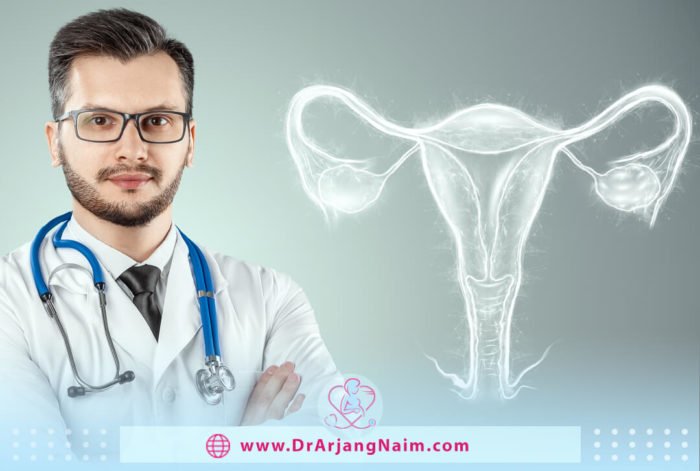Hysterosalpingography or HSG is a technique in which a special type of X-ray called fluoroscopy can be used to take pictures of the inside of the uterus and fallopian tubes and examine them. HSG can also be used to identify some infertility problems. It is possible to observe the internal organs during which the uterus and fallopian tubes are filled with water-soluble contrast agents, and the radiologist can use fluoroscopic materials to observe the structure and function of the uterus and fallopian tubes.
Preparing for the test
Some women find this test painful, so that doctors may prescribe a painkiller. This medicine should be taken about an hour before the operation. The doctor may use sedatives to help with relaxation if necessary, and antibiotics may be prescribed before or after the test to help prevent infection.
This test is done a few days to a week after menstruation. This is to make sure women are not pregnant. It also helps reduce the risk of infection. Also, if a person has pelvic inflammatory disease (PID) or unexplained vaginal bleeding, they should not have this test. This X-ray test uses a contrasting dye. Contrast dye is a substance that helps to highlight certain organs or tissues around them when swallowed or injected. It does not stain the organs and is excreted in the urine or dissolved in the body.
The metal can interfere with the X-ray machine. Before the operation, the person is asked to remove metals on their body, such as jewelry.
What happens during the test?
This test requires wearing a hospital gown, lying on the back, bending knees, and spreading legs like a pelvic exam. The radiologist then inserts a speculum into the vagina. This is done so that the cervix behind the vagina can be seen. It may make you feel a little uncomfortable.
The radiologist then cleans the cervix and may inject a local anesthetic into the cervix to reduce discomfort. An instrument called a cannula is then inserted into the cervix, and the speculum is removed. The radiologist inserts the dye through the cannula, which flows into the uterus and fallopian tubes.
The client is then placed under an X-ray machine, and the radiologist begins to take X-rays. The person may be asked several times to change position so that the radiologist can record different angles. When the dye moves through the fallopian tubes, it may cause some pain and tightness. When an X-ray is taken, the radiologist removes the cannula. The appropriate medication is then prescribed to prevent pain or infection.
What happens after the test?

After the test, the client may still have cramps similar to those experienced during the menstrual cycle. May also experience vaginal discharge or light vaginal bleeding. To prevent infection during this period, the woman should use a pad instead of a tampon. Some women also experience nausea and dizziness after the test.
These are natural side effects and will go away. However, tell the doctor if you have any of the following symptoms:
- Fever
- Severe pain and cramping
- Foul-smelling vaginal discharge
- Fainting
- Heavy vaginal bleeding
- Vomiting
After the test, the radiologist sends the results to the doctor. Depending on the results, the doctor may want to perform further examinations or order more tests.
Complications
HSG is considered a very safe method. However, there are several known complications, some of which are serious, occurring in less than 1% of cases.
Infection
The most common serious problem with hysterosalpingography is pelvic infection. This usually happens when a woman already has a fallopian tube disease. In rare cases, the infection can damage the fallopian tubes or require removal. If a woman increases pain or a fever within 1 to 2 days after HSG, she should contact her doctor.
Fainting
Some women may experience dizziness and nausea after hysterosalpingography. These side effects are normal and will eventually go away.
Radiation exposure
The amount of radiation caused by hysterosalpingography is very small. But HSG is not recommended during pregnancy.
Iodine allergy
Rarely may a woman be allergic to the iodine used in this procedure. If you are allergic to iodine and seafood, tell your gynecologist. In such cases, if you experience complications such as rash, itching, or severe swelling after hysterosalpingography, contact the doctor immediately.
Spotting
In some cases, spotting and, rarely, bleeding may occur 1 to 2 days after hysterosalpingography. If a woman develops heavy bleeding after it, notify her gynecologist immediately.
Benefits
The benefits of HSG include:
- It is a minimally invasive procedure with rare complications.
- It is a relatively short procedure that can provide valuable information on a variety of abnormalities that cause infertility or problems carrying a fetus to the term.
- It can occasionally open fallopian tubes that are blocked, allowing the patient to become pregnant afterward.
- No radiation remains in a patient’s body after an x-ray examination.
- X-rays usually have no side effects in the typical diagnostic range for this exam.
Is pregnancy after an HSG more likely?
A water- or oil-based contrast agent is placed in the uterus and fallopian tubes. This fluid contains a dye that makes the shape of the uterus and fallopian tubes visible on an X-ray screen. Contrast can also be used as a treatment for tube flushing.
While the contrast may not make a difference to the fertility test itself, it seems to be important in assessing the increase in pregnancy after HSG. The use of oil-based or water-based contrast agents can increase the rate of pregnancy during the first six months, although the use of oil-based contrast agents increases even more.
If tubes are blocked, what is the next step?
If the tubes are blocked, the doctor may recommend a surgical procedure to look directly at the tubes or bypass the tubes and perform in vitro fertilization. This is a complex decision that should be discussed with the doctor.
What are the limitations of hysterosalpingography?
This examination only looks inside the uterus and fallopian tubes. The doctor may use MRI or ultrasound to look for problems with ovaries, uterine walls, and other pelvic structures. This test cannot assess infertility problems due to low or abnormal sperm count or a fertilized egg’s inability to implant in the uterus.
Are there alternatives to HSG?

Other procedures can give health care providers some of the same information as HSG:
- Laparoscopy: Laparoscopy is a modern method of surgery performed surgeries on the abdomen and pelvis. During this operation, the surgeon inserts thin, delicate instruments into the abdomen and parts of the pelvis through very small incisions. One of the instruments inserted into the abdomen is a laparoscope that sends a live image of the abdomen and pelvis to the monitor. This surgical procedure requires general anesthesia.
- Hysteroscopy: In hysteroscopy, a telescope-like device is inserted into the uterus through the cervix. The doctor then looks directly at the uterus and uterine walls for any internal adhesions, polyps, or fibroids. In addition to performing this type of surgery, any abnormality and pathology inside the cervical canal and uterine cavity can be treated simultaneously with hysteroscopy and in the same session. Therefore, this method is considered diagnostic and therapeutic. However, it cannot indicate whether the fallopian tubes are blocked.
- Sonohysterography: Sonohysterography is a special type of ultrasound examination. Fluid enters the uterus through the cervix using a thin plastic tube. Sound waves are then used to create images of the lining of the uterus. The fluid helps to show more detail than when ultrasound is used alone. This method does not provide information about the fallopian tube.
The bottom line
Hysterosalpingography is the color imaging of the inside of the uterus and fallopian tubes with the help of X-rays. In this type of imaging, a contrast agent is used to capture clear and accurate uterus images and its tube. The best time to visit is usually after the end of the menstrual period and before ovulation.
Additional questions
1. Why is iodinated contrast used in Hysterosalpingogram?
Iodine contrast is injected into the cervix, allowing the cervix and fallopian tubes to be evaluated. Determines the exact size and shape of the uterine cavity.
2. What is the most common cause of tube blockage?
The most common cause of blocked fallopian tubes is Pelvic inflammatory disease. PID results from a sexually transmitted disease, although not all pelvic infections are related to STDs. Also, even if the PID is no longer present, a history of PID or pelvic infection increases the risk of tubal obstruction.
3. Can sperm get stuck in fallopian tubes?
If the fallopian tube is blocked, the path of the sperm to reach the egg is blocked, and the return route to the uterus for the fertilized egg.
4. What are the side effects of having fallopian tubes removed?
Removal of the ovaries and fallopian tubes in women at any time before menopause causes women to undergo immediate surgical menopause, leading to short-term side effects such as hot flashes, night sweats, and mood swings, and long-term side effects, including heart and bone disease.
5. Will ovulation occur if the tubes are blocked?
If there is a blockage in one of the fallopian tubes, the obstruction is unlikely to affect fertility because the eggs can still travel through the opened tube to the uterus. In this case, the doctor may prescribe fertility drugs to increase the chances of ovulating on the healthy side.
References:
https://www.acog.org/womens-health/faqs/hysterosalpingography
https://www.verywellfamily.com/will-an-hsg-help-me-get-pregnant-1960166
https://www.radiologyinfo.org/en/info/hysterosalp
https://www.webmd.com/infertility-and-reproduction/guide/blocked-fallopian-tubes-test
https://www.esmil.com/reproductive-scans/hysterosalpingography/benefits-risks.php
https://www.healthline.com/health/hysterosalpingography#aftercare




